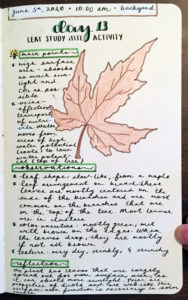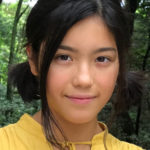On Day 21 of “30 Days of Reconnection,” I sat by the garden and reflected. I watched ants on the lemon tree, heard the buzz of bee’s wings, and smelled ripening tomatoes in the cool morning breeze.
Introduction
When the warm days of summer blend together and the days melt into weeks, in the midst of a pandemic, there has never been a better time to dive into nature and connect with our surroundings.
As a high school student in love with biology and design, I’m fortunate to live in California, a landscape overflowing with nature’s creations. But it wasn’t until I found the Biomimicry Institute this summer that I learned how to see landscape as a living, ancient system eager to lend its wisdom. I was planning to learn more this summer, to take the opportunity to explore multiple subjects at the same time, without the structure and limitations of regular classes. But when the pandemic arrived, all my summer plans got cancelled. That’s when I started working on the 30 Days of Reconnection activities, and I’m so glad I did!
Day 1 Journal Sketch
 I started Day 1 of my journey with a blank sketchbook, a perfect blank canvas to introduce a new lens to view from.
I started Day 1 of my journey with a blank sketchbook, a perfect blank canvas to introduce a new lens to view from.
Day 1’s prompt was to explore the meaning of the word “regenerative.” At first, I didn’t have many ideas, but once I started writing, the inspiration started to flow. I thought about recycling and how strange it is that so many of our everyday items get used once and thrown away. I thought about the long drives through California’s Central Valley and how farmers regenerate nutrients in the soil to grow food for millions of people year after year. I thought about the mysteries of stem cell biology and how animals like starfish can regrow body parts and wondered if someday humans might discover a way to do the same. Following the first day’s instructions, I personalized the page with a sketch of my favorite animal, the mascot of my birth year on the Chinese zodiac — a monkey.
The Day 1 exercise unlocked ideas about nature I didn’t know I had. It also began to seed the concept of learning from nature, rather than merely about nature.
I set down my pens and closed the sketchbook anticipating what the next 29 days might bring.
Day 2
The second day focused on the five senses. I sharpened my nose, eyes, and ears to gather more information about my environment — the sound of wind in the trees, the smell of sunlight on the leaves and flowers. I watched a video called The Sounds of Survival about how creatures use their senses. 48 hours into the reconnection exercise, and I was empathizing with Honduran Bromeliad Tree Frogs.
For the next 11 days, I went outside a few times each day, following the prompts and making notes. I watched a TED Talk by Biomimicry Institute Co-founder Janine Benyus called “Creating a Bio-industrial Revolution.”
I also watched a video called “What Nature Can Teach Us About Life.” It tells us we are born “to be in awe of the oceans, landscapes, and stars” and showed me how we are part of something so much bigger than ourselves.
Each day brought more to read, more to sense, and more to watch and learn.
Day 13
 When Day 13’s prompt said “Time to go outside! Collect a leaf… observe the leaf shape… and try to sketch what you see,” I was ready!
When Day 13’s prompt said “Time to go outside! Collect a leaf… observe the leaf shape… and try to sketch what you see,” I was ready!
I examined the oak leaf from my neighborhood and sketched the details of its exterior. As I was drawing, I noticed the thick main veins that guided the thinner ones. The veins resembled a net, which, according to my biology classes, belongs to a dicot plant. As I continued sketching and examining, I began combining what I knew from biology textbooks with the input from my senses, formulating new scientific explanations of the leaf’s systems. The science I learned in previous years felt less monotonous and more inviting. I realized chemistry and biology are not separate fields — there are many areas where they overlap! An example of this, which I included in my journal entry, is an idea about how water travels in leaf veins and how that connects to hydrogen bonding (chemistry) and water loss (biology).
I learned so much by Day 13 of the activities. The experience was different than just sitting at a desk and taking notes on a long article. Each time in the process of journaling, I would think of a question relevant to the day’s prompt, search for an answer, and come across yet another question. It was a cycle of self-initiated learning fueled by curiosity. The new information stuck!
Day 21
During the series, I was really into the flow of observing, searching, learning, and writing. I would say that one of the clearest benefits biomimicry had on my life was that it allowed me to open my eyes to nature. Before my introduction to 30 Days of Reconnection, the outdoors felt separate. After being exposed to the mindset and science of biomimicry, I started noticing every little detail. An illustration of this idea can be seen in my Day 21 journal snapshot.
By the middle of the program I was making dozens of observations a day. Here are a few observations I made, just through sitting outdoors and looking at my surroundings.
I realized how…
- A citrus tree will never bear more fruit than it can handle, even when the branches bend like crazy!
- The flapping of a hummingbird’s wings is faster and more delicate than any motors I’ve ever seen
- The bark on trees is so tough on the outside yet smooth on the inside. Could this bark design be applied to new types of insulation?
- Fluid transport through the veins on leaves act in a similar fashion to blood transport in arteries. There are so many recurring patterns that span across nature!
Over the following days, I continued observing and reflecting; but among all the activities, my favorites were the enrichment videos. I was first introduced to the BBC Nature videos from Day 18 of the series, but later watched more of them in my free time. I loved the video about beavers and was astonished at how they sawed down trees just using their teeth. Imagine what these beavers could teach us about designing structures without the use of toxic materials or heat, beat, and treat methods! The strength of their teeth could be used to understand human tooth decay, while the insulation of their hibernation lodge could be mimicked in actual homes. This video was a powerful example of the power of observation. I strongly recommend it.
Advice for Readers
You don’t need much to start the 30 Days Reconnection activities — just prepare something to write your thoughts down on and have an open mind! You will be astounded by your surroundings. The journaling experience will expand your understanding of nature and the subtle genius of its designs. Just allow your thoughts to flow. Once you’ve learned to see the potential for biomimicry, you’ll realize we are surrounded by designs passed down to us over billions of years of refinement. I hope you enjoy your own 30 Days of reconnecting to nature (and yourselves!) this summer!
 Sophia Stiles is a high school student based in California. In her free time she enjoys drawing and taking walks with her family.
Sophia Stiles is a high school student based in California. In her free time she enjoys drawing and taking walks with her family.

